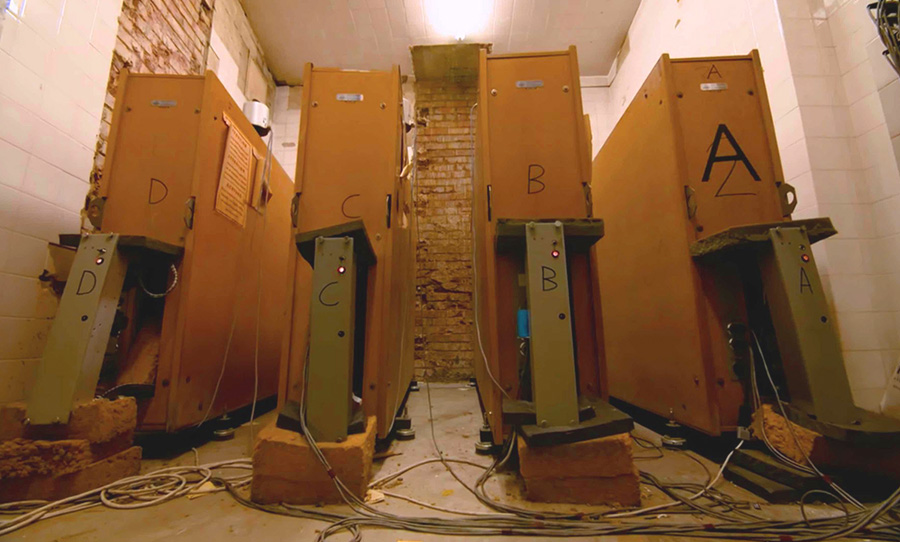We’ve all heard it, but maybe not all of us has recognised it by its name. The boxy sound of bathroom conversations, the cacophony of sonic information in a crowded school hall, the celestial tails at the end of notes from a symphony orchestra. It’s reverberation (reverb for short) and it’s created by the scattered reflections of sound in chambers of all shapes and sizes. It’s also used to create all types of dramatic and mysterious musical moments.
 A look at the creation of artificial reverb via mechanics and digital manipulation, the types of reverb and how they’ve been used and abused over the decades.
A look at the creation of artificial reverb via mechanics and digital manipulation, the types of reverb and how they’ve been used and abused over the decades.
The challenges with reverb involve control and authenticity: how does one emulate the sound of a cathedral, for example, within the conveniently controlled surrounds of the studio? This article will focus on the artificial reverb, via mechanics and digital manipulation, the types of reverb and how they’ve been used and abused over the decades.
The Early Days
In the early epoch of commercial studios, the two most common ways of creating mechanical reverb was with the use of the plate and the spring.
In plate reverb machines, like the esteemed EMT 140, the dry signal is sent to a driver attached to a plate, which creates the reverberated sound. The plate’s pickups send the affected signal back to a channel on a console, ready to be mixed with the raw source. As you can see here the device is unwieldy and needs a lot of space to be utilised properly.
With its consistent decay and uniquely musical character, plate is undoubtedly a versatile and sought after sound. Perhaps most famously though, the plate performs best with percussion – the hard transients offered by drum sounds couple well with the plate’s crystalline fade out.
Enter its lower cost and decidedly more practical cousin, the spring reverb. The signal path for the spring and plate reverb is essentially the same, a driver sending sound into the device, then being returned via a pickup. What differs is the method of reverb production – the springs in this reverb are housed in a compact tank, which vibrate to create its customary scattered and metallic character.
In the 1960s, spring reverbs were ingeniously incorporated into the guitar and organ amplifiers and thus imparted an indelible tonal fingerprint on the rock and psychedelic sounds of the era. To hear it in all its sun-soaked glory, it’s hard to go past Misirlou by Dick Dale. Like the plate, the sustaining effect is exacerbated by a sharp attack.
In the pre-digital era, entire chambers were used for the purpose of introducing reverb into a mix. In principle, they’re quite easy to envisage – pump sound through to a speaker fitted in the chamber, the sound gets picked up by a microphone elsewhere in the space, then sent back to a mix.
In today’s economically rational times, where real estate is precious, it’s hard to imagine that these places ever existed. Yet exist they did, and were used to create effect, especially in the seminal Capitol Studios which has built eight independently designed reverb chambers right underneath the studios. Who better to explain the virtues of the reverb chamber than James Taylor, who built one using a shipping container.
In The Digital Era
EMT were pioneers in the both mechanical and digital reverbs. The 140 was their plate model that was made available in 1957. Their 250 model, released in 1976, became the first digital reverb.
Plates and springs, iconic as they are, don’t pretend to emulate what it is exactly like to be in room. Mechanical reverbs are somewhat limited in their tonal scope and one you get used to the sound of a plate or spring, they’re impossible to mistake for anything else.
Digital reverbs rely on algorithms to create complex envelopes, with parameters such as pre-delay, early reflections and decay times being eminently more malleable than their mechanical ancestors. As such, these devices became highly sought after for their versatility – classics like the Lexicon 224 were seemingly only limited to the user’s imagination.
Another development in digital reverb is convolution. The algorithms used to create this type of reverb are not exactly easy to explain – essentially, an actual physical space is recorded to create an impulse response – a snapshot of the reverberant characteristics of that particular space.
The sound sent to a convolution reverb triggers the impulse and therefore, a real sample of that space, a concert hall for example, rather than an emulation of a concert hall typical of standard digital reverbs, is available to be blended with the mix.
Approaching reverb can be complicated – digital reverbs (especially those in plug in form) offer so much in the way of presets and parameters, it can be easy to get lost in the minutiae and forget why you chose it in the first place. In terms of tweakability, the first mechanical reverbs were primordial in comparison, yet the sounds were, and continue to be, quintessential.
It’s also worth remembering that their digital descendants are in many cases just trying to emulate their forefathers, so a basic background knowledge in the origins of the different types of mechanical reverb – how they work, how they react – could help you to make better choices on the search for ambience in your mix.


